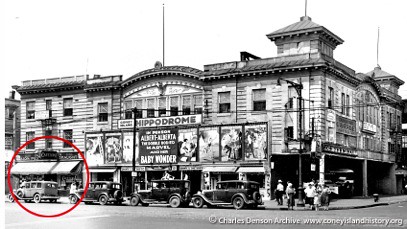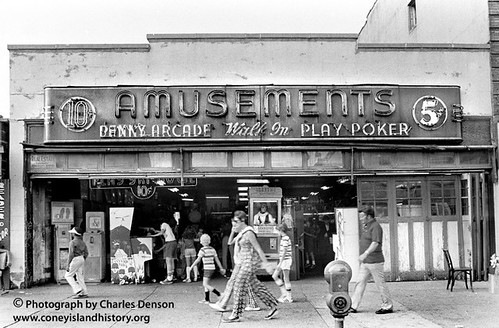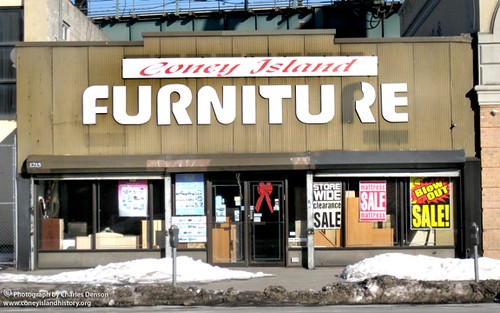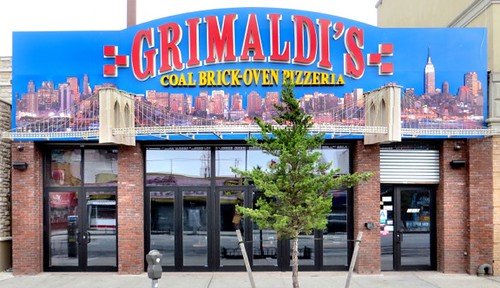
Grimaldi’s at 1215 Surf Avenue, with its sleek glass facade and bold picturesque signage, appears to be modern, but the building has a fascinating history that represents the century-long transformation of the street’s north side. The structure is a small remnant of the 1907 Lido Hotel on West 12th Street (first known as the Boston Hotel and later as the Coney Island Hippodrome). The original tenant was a cafeteria, the first of several restaurants that would operate at that location.

Lido Cafeteria at 1215 Surf Avenue in the 1920s. Photo © Charles Denson Archive, Coney Island History Project
During the 1940s, the building was reduced to one story and transformed into a penny arcade that operated until the 1970s. Surf Avenue’s north side between West 12th and Stillwell Avenue once boasted dozens of attractions including the Crazy Ghosts dark ride, a McCullough carousel, a billiard parlor, the Hollywood Bar, a bowling alley, the Mardi Gras Movie Theater, and the Lido's Theater, home to 1940s sideshows and the Bread and Puppet theater troupe during the late 1960s.

Amusement arcade at 1215 Surf Avenue in the early 1970s. Photo © Charles Denson via Coney Island History Project
All were gone by the mid-1970s. The building at 1215 Surf, like many others on the avenue’s north side, became a cut-rate furniture store, a business not permitted under amusement zoning. The adjacent Lido Hotel was destroyed by fire in the early 1980s but the one-story section now housing Grimaldi’s survived. The vacant Lido site became a flea market, replaced in 2002 with the three-story building currently on the site.

Coney Island Furniture at 1215 Surf Avenue in the 1990s. Photo © Charles Denson via Coney Island History Project
A 21st-century resurrection of the block includes the restored Stillwell Avenue Terminal, Applebee's, a proposed Johnny Rockets, two bars, a strip club, and the offices of Community Board 13 and the Alliance for Coney Island.
At the center of it all is Grimaldi’s Brick Oven Pizzeria, located in a structure whose interior of exposed brick walls are the only clue to the building’s historic past.

Grimaldi's Pizzeria at 1215 Surf Avenue since 2012. Photo © Charles Denson via Coney Island History Project
This post is part of series titled "Then and Now: Finding Coney Island's Hidden Landmarks" by Charles Denson in the Director's Blog.

Comments
Your Project and Photos
I am thrilled to see all that you have documented about Coney Island and would love to see more. I was born in 1945 and lived there until leaving Brooklyn at age 22. I went to Washington Baths every summer with my mom to play tennis and sit in the steam baths, swam in the pools and the ocean, enjoyed Steeplechase for many seasons and rode so many rides on our walk home from Washington Baths.. I did not know it was Trump who destroyed it. I watched the wonderful small homes on Ocean Parkway demolished to make way for despicable Trump Tower which people clamored to live in, to my dismay . How can I see more of your photos? I wish I had known about the exhibit at the Brooklyn Museum. I have lived in Northern California for many years and have lost touch with Coney Island's going on. I do visit occasionally and have witnessed so many of the changes over the years. Thanks for all the loving work you have done.
Cosmos Cafeteria Surf Avenue
My mother's uncle owned Cosmos Cafeteria between WW I and WW II - does anyone have pictures or information about Cosmos?
Lido Hotel
I'm looking for pictures of the Lido Hotel as it may have appeared the 60's, will someone help me?
Add new comment